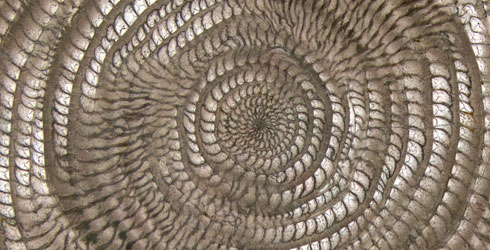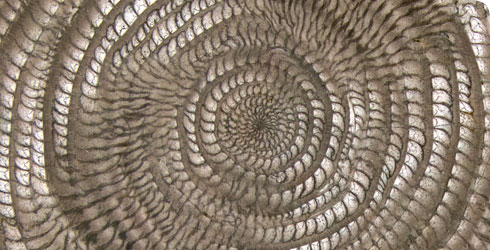Nummulites gizehensis
Nummulites gizehensis is just one species in a large group of fossilised single-celled (protozoan) marine animals called foraminifera.
Foraminifera have been called 'armoured amoeba' because they secrete a tiny shell or test usually about a 1.5mm long. The name foraminifera comes from foramen, an opening or tube that interconnects all the chambers of the test. Fossilised test are found in sediments as old as the earliest Cambrian (about 545 million years ago). Foraminifera can still be found in abundance today, living in marine and brackish waters
Nummulites are valued for their use in biostratigraphy, correlating and assigning relative ages of rock strata using the fossils contained within them. Nummulites are therefore to referred to as index, or guide fossils.
Species detail
Nummulites gizehensis is one of a sub-group of foraminifera referred to as ‘Larger’ foraminifera. Larger foraminifera are typically disc-shaped and contain many growth chambers, which form an intricate internal structure seen only when specimens are broken or cut open. Some of the largest ‘Larger’ foraminifera can grow up to 15cm in size, but still consist of a single-celled organism.
The name "Nummulites" is a diminutive form of the Latin nummulus meaning "small coin", a reference to their shape.
-

Taxonomy
Find out how Nummulites gizehensis fossils are studied and classified and get further information regarding the appearance, distinguishing features, lookalikes and the evolution of this species.
-

Distribution
Discover where Nummulites gizehensis fossils have been found and the type of environment the species would have lived in.
-
Biology
Read about the size and growth patterns of this bottom-dwelling species.
-
Behaviour
Learn about the symbiotic relationship Nummulites gizehensis shared with a green algae and the feature of shell construction known from all nummulitids.
Images

The myiad tiny chambers of Nummullites gizehensis, once occupied by the animals, are sometimes found to be filled with crude oil.

Micropalaeontologists study the abandoned, dead shells of foraminifera. This involves detailed study of the internal chamber arrangement, especially of the initial chambers and is accomplished by splitting, or by making wafer-thin sections of specimens.

Nummulites gizehensis - specimens have been split open naturally by the break in the host rock to reveal their internal structure.
About the author
Clive Jones
Former Collections Manager, Micropalaeontology, Department of Palaeontology.
